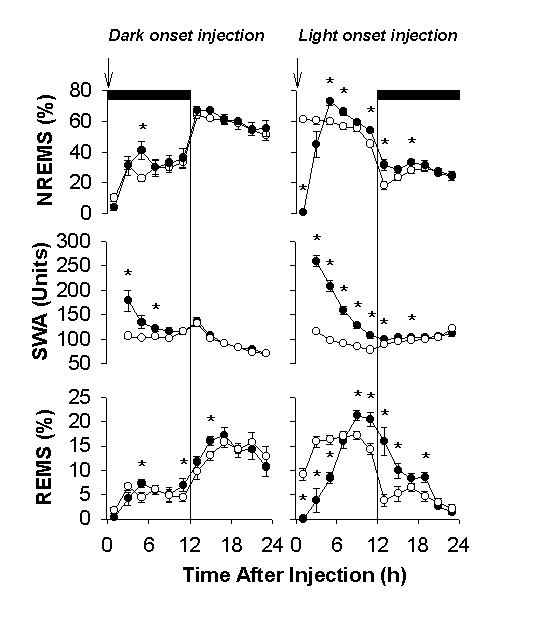Frederick J. Gandolfo
and Levente Kapás
Introduction: Several lines of evidence indicate that excitatory amino acids (EAAs) have an important role in the regulation of sleep (1). Accordingly, the most abundant EAA in the central nervous system (CNS), glutamate, has been demonstrated to have an effect on the regulation of sleep and the modulation of the circadian rhythm. Glutamate, via the N-methyl-D-aspartate (NMDA) receptor, is also the strongest stimulus for the production of nitric oxide (NO) by neurons (2). Previously, the inhibition of NO production has been shown to have a complex phase-dependent effect on sleep (3). The aim of the present study was to determine if the effects of a non-competitive NMDA receptor antagonist, MK-801, on sleep are also phase-dependent. Methods: Male Sprague-Dawley rats (370-520 g) were implanted with EEG and EMG electrodes. The rats were kept on a 12:12 h light-dark cycle, light onset at 1000 h. On the control days, all rats received saline intraperitoneally (ip, 2 ml/kg) at either dark onset or light onset and sleep was recorded for 23 h. Dark onset: On the experimental day, the rats (n = 8) received 0.25 mg/kg MK-801 ip and sleep was recorded starting at 2200 h. Light onset: On the experimental day, the rats (n = 7) received 0.25 mg/kg MK-801 ip and sleep was recorded starting at 1000 h. Food and water were provided ad libitum. Results: Systemic
injection of 0.25 mg/kg MK-801 at light onset completely suppressed non-rapid
eye movement sleep (NREMS) for the first 2 h. This effect was followed
by a positive rebound in NREMS, which remained significantly elevated during
the transition from the light period (LP) to the dark period (DP).
Rapid eye movement sleep (REMS) was initially suppressed for 6 h following
injection, with a large positive rebound occurring from h 9-16. Slow-wave
activity (SWA) showed a 150 % increase from baseline after NREMS reappeared,
i.e., during the second 2 h of the LP, and remained elevated throughout
the remaining LP and the first 2 h of the DP as it returned to baseline
levels. Systemic injection of 0.25 mg/kg MK-801 at dark onset caused
tendencies towards decreased sleep for the first 2 h period. After
sleep returned to baseline, there was a significant increase in NREMS and
REMS during h 5-6. REMS was slightly elevated during the last 2 h
of the DP and during the first 4 h of the LP. SWA showed a significant
increase during h 3-4 and remained slightly elevated for the next 6 h.
Previous trials using 0.01 mg/kg or 0.05 mg/kg MK-801 were performed with
no appreciable effects.
Conclusions: The effects of MK-801 on sleep depend on the time of administration. The effects of MK-801 on NREMS and REMS after dark onset and light onset administration closely resemble the phase-dependent effects of NO synthase inhibitors on sleep. These findings are in line with our hypothesis that NO may play a role in the effects of EAAs on vigilance. References:
Support: Research
supported by NIH (NS-30514).
|
